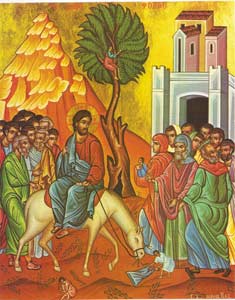Feast of the Entry into Jerusalem
According to Byzantine Catholic Tradition, the Great Forty Days Fast ends on the Friday before Palm Sunday. The following day, Saturday, celebrates the Raising of Lazarus as a prelude to the triumphal entry of Christ into Jerusalem. For many, the miracle of Lazarus was convincing proof of Christ’s Divinity. The public celebration in Jerusalem was not only for Jesus, but also to see Lazarus, whom He had raised.
From ancient times, palm branches were symbols of victory and triumph, and were used by Romans in celebration of both military as well as civic and sporting events. Thus, when Jesus arrived the people took branches of palms and went out to greet him. In the New Testament, palm branches became a symbol of martyrdom, meaning victory over death.
The Feast of Palm Sunday dates back to at least the third century, having been celebrated first in Jerusalem and quickly spreading to all of the churches in the East, reaching Constantinople by the fifth century. It was also known as Flowery Sunday, since in and near Constantinople spring flowers (lilac, olive, or elder) were distributed to the faithful. Between the sixth and seventh centuries the feast spread to the western church. In the West, the palms are kept for an entire year, then burned, with the ashes spread on the foreheads of the faithful on Ash Wednesday as a sign of penance.
In many countries of Europe the Feast is known as Willow Sunday or Pussy Willow Sunday. Since palms do not grow in northern climates and may not be available, pussy willows, being the first flower to blossom in Spring, were often distributed. Depending on local customs, churches today may distribute palms, pussy willows, spring flowers, or a combination.
